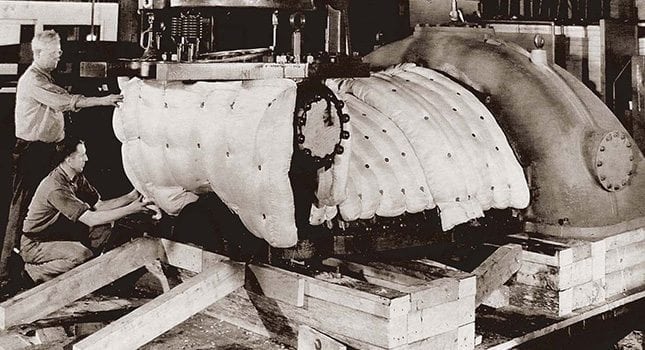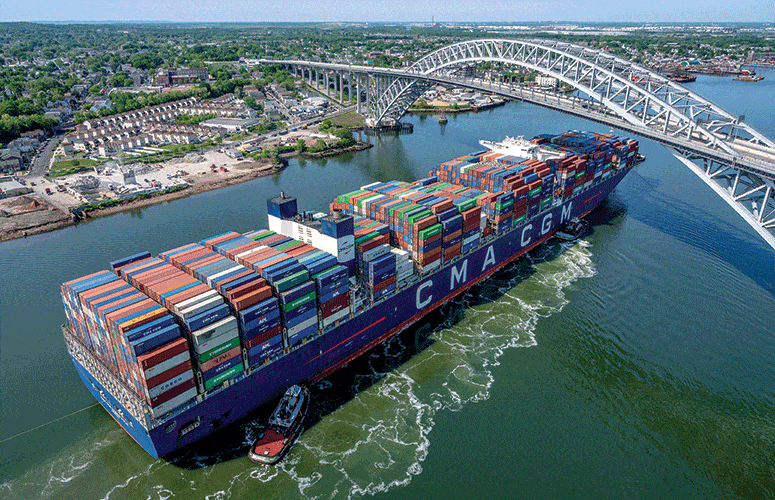
We Are The Birthplace of American Innovation
By Donald H. Sebastian On Mar 6, 2014While other states have become the face of a single industry – Detroit for automotive, Pittsburgh for steel, Texas for oil – history shows that New Jersey gave birth to almost every major industry sector. It has been a place where great inventors came to create great businesses because the state had: the space to build factories; the workforce to man them; the transportation networks to move goods to market; and access to New York’s financial center.
New Jersey’s history as an industrial and innovative state dates back to the colonial era. Iron ore deposits in the Highlands created an industrial base for refined ore production and wrought iron goods that grew to eclipse Great Britain as a source of smelted iron. During the Revolutionary War, this industrial base was an important source for cannons, cannon balls and musket barrels.
Early Nation Days
As the nation moved forward in independence, the founding fathers recognized the importance of a robust production sector. In 1792, Treasury Secretary Alexander Hamilton supported the request of the Society for the Establishment of Useful Manufactures to create Paterson as a “national manufactory, adding wealth, independence and economic security to a fledgling democratic nation.” Over the years, Paterson produced many industrial firsts: the water-powered cotton spinning mill (1793); continuous roll paper (1812); and the Colt Revolver (1836). It became “Silk City” with printing, dying and weaving that survived into the late 1900s. Paterson manufacturers produced more than 10,000 steam locomotive engines including Rogers Locomotive Works’ Union Pacific No. 119, used in the ceremonial driving of the Golden Spike completing the transcontinental railway in 1869.
Newark became a center for leather tanning and the manufacturing of finished leather goods. Seth Boyden invented the process for making patent leather, malleable iron and an inexpensive process for making sheet iron. By the time of the Civil War, the city was a key supplier of boots, saddlery and related gear for the Union Army. With the completion of the Morris Canal in the 1830s, the Essex Railroad, a network of turnpikes connecting Newark to surrounding communities and Newark Bay as a port for broader exchange, Newark was situated in the middle of a transportation network critical to commerce growth.
In Hoboken, Colonel John Stevens developed the steamboat before Robert Fulton, and designed the first American-built steam locomotive (1825). His son Robert invented the modern T-rail, and with his brother, Edwin, built and operated the first commercial railroad in the United States. Edwin was active in developing ironclad vessels for the US Navy, and it was Edwin’s bequest that established Stevens Institute of Technology on the family’s Castle Point estate (1870).
Trenton grew to become an important center for iron works, ceramics (Lenox China, 1889) and rubber. We think of Akron as the home of the US tire industry, but in fact, Trenton was the “nation’s tire capital” up until the end of World War I. John A. Roebling, architect of the Brooklyn Bridge, had established his wire and cable business in Trenton in 1848. After his accidental death building the bridge, his sons grew John A. Roebling & Sons into the world’s leading producer of wire rope, supplying the George Washington, Golden Gate and other famous suspension bridges.
Camden businesses included milled products, pork sausage, candles, manufactured carriages and wagons, leather good and shipbuilding. All of this activity created a landscape for innovation that, coupled to manufacturing capacity, literally exploded in a super nova of new technologies in the late 1800s. This would anchor the American economy for the century to come.
Electric Light & Power
It is impossible to talk about New Jersey’s innovative history without talking about Thomas Edison, who came to the state in 1867. With a world record of more than 1,000 patents, his work created the base for new industries and improved existing ones. In the process, he created the concept of the industrial research center that took innovation from a solitary pursuit to an organized, methodical, results-driven effort that would foreshadow Bell Labs, Sarnoff Research and many others.
While not his first invention, perhaps Edison’s most enduring legacy was the development of electric power generation and distribution. Using the proceeds from his earlier inventions, he built successively larger labs in Newark, Menlo Park and, finally, West Orange – which at its peak employed 10,000. In Menlo Park, he completed the carbon filament bulb in 1879. Soon came the entire system of switches and outlets, distribution and generation to begin operating the first public electric utility in Manhattan in 1882. Over time, the Edison Electric Light Company became the basis of General Electric and the Con-Edison utility in New York.
Edison’s success stimulated competitors who made great contributions to the industry. Newark inventor Edward Weston developed electric generating dynamos as alternatives to battery power for electroplating operations in the 1870s. He adapted these to public power generation while also making improvements to incandescent light filaments using celluloid materials already commercialized in Newark. He brought lighting to Military Park in Newark in 1878 and lit the Brooklyn Bridge. He also developed current and voltage meters critical to growth of the power industry. Weston and his Newark colleagues petitioned to form a new kind of educational institution, offering degree programs that would train the type of technical specialists that companies such as his needed to grow. Their petition was granted and the Newark Technical School began operating in 1884. In time, the school would be renamed as Newark College of Engineering and, finally, NJIT (1975).
Telecommunications, Broadcast & Recording
Alexander Graham Bell invented and launched the telephone in Connecticut, but the growth of AT&T into “Ma Bell” belongs to New Jersey. Edison even played a role in telephony as his invention of the carbon microphone (1877) was used in handsets from Bell’s first phones up until the 1980s. By 1882, AT&T had moved to New York and the company acquired Western Electric to manufacture components with the standardization necessary for a national enterprise. Western Electric established its Kearney Works (1923) as one of the company’s major production centers, and its Western Electric Research Laboratories combined with part of AT&T’s engineering department to form Bell Telephone Laboratories, Inc. Over time, Bell Labs established a number of state-based operations, ultimately relocating to its current home in Murray Hill (1941). The contributions to modern technology are too numerous to discuss in detail, but early Bell Labs discoveries include the first fax (1925), first synchronized moving picture & audio (1926), first long distance TV transmission (1927), and first stereo transmission (1933). The transistor that gave birth to solid state electronics and ultimately enabled digital processing was patented in 1947, solar cells in 1943 and various computing machines in the 1940s. Cellular communications, lasers and fiber optics, CCD cameras and thousands of other inventions would also come from the New Jersey labs.
In 1884, Edison discovered the effect that would, 20 years later, become the basis of vacuum tube electronics. The experiences of John Ambrose Fleming, who worked for the Edison Electrical Light Company (1882) and later the Marconi Company (1889), inspired his invention of the two-electrode vacuum-tube rectifier in 1904, which was critical to the growth of radio communication. These technologies grew rapidly. After World War I, the Army, having taken control of the US Patents during the war, transferred the assets of the Marconi Wireless Telegraph Company of America to a new corporation called the Radio Corporation of America (RCA). David Sarnoff came from Marconi as part of the deal and he would oversee a remarkable expansion of RCA to include the formation of NBC, the advent of television and, later, color television, laser discs and all of the technologies that made commercial broadcasting possible.
Edison invented the cylinder phonograph in 1877, but another New Jersey inventor developed the technology that would rule the consumer market for the next century. Camden machine shop owner Eldridge Johnson was hired to design a low-cost spring wound motor for the Gramophone, a machine that played flat disks instead of cylinders. After forming the Victor Talking Machine Company in 1901, Johnson continued to pioneer disk recording and manufacturing, even developing the automatic record changer, overcoming the limitation of short playing times to allow uninterrupted listening of operatic and symphonic content. As electronics replaced mechanical and acoustical systems for musical reproduction, his company merged with RCA (1929), forming RCA-Victor.
In the 1890s, Edison began working on motion picture technology, beginning commercial production of movies in 1893. He created the first motion picture studio in West Orange where he moved his labs in 1887. His invention was aided in a circular way by another discovery in Newark. In 1882, a chemist working for the Celluloid Mfg. Co. of Newark discovered that opened, the hard plastic material Celluloid could be dissolved in amyl acetate then spread into a thin layer. After the solvent evaporated, a stable, flexible film remained. The discovery was ultimately commercialized by Eastman-Kodak as a vast improvement over paper-backed films.
Petroleum, Chemicals and Plastics
Edgewater, along the Hudson River opposite Manhattan, was home to some of the earliest chemical operations in New Jersey. The Hudson River Dye Wood Mills began to manufacture sulfuric acid in 1843. The Hudson River Chemical works produced the sulfuric acid for coal oil and the rapidly emerging petroleum refining industry in the metropolitan area. An 1899 merger of eleven chemical producers created General Chemical Co. that, by 1903, operated giant commercial sulfuric acid plants in Edgewater and Camden. In 1921, General Chemical joined several other companies, including the Allied Chemical and Dye Corporation, which over time became Allied Signal – now Honeywell – with headquarters in Morristown.
In 1882, Standard Oil provided the lubricants for Thomas Edison’s first central generating system. In 1885, Standard Oil moved its headquarters from Cleveland to New York City and incorporated in New Jersey to take advantage of lenient corporate stock ownership laws. In 1907, Standard Oil acquired several hundred acres between Linden and Elizabeth, as the site for its Bayway refinery, completed in late 1908 and still operating today as Phillips 66.
When Standard Oil was broken up into smaller units in accordance with the Sherman Antitrust Act (1911), one of the successor companies was Standard Oil Company of New Jersey, which came to be known as Esso (S.O.- “Ess-Oh”) and later Exxon. Bayway was the leading research facility within the Esso enterprise. It was the first facility in the United States to employ the use of the hydrogenation process to get greater yields from its crude products, and in 1919 scientists at Bayway created the world’s first petrochemical: isopropyl alcohol.
In 1917, Vacuum Oil Co., divested in the 1911 Standard Oil break up, purchased land in Paulsboro to build a new plant to produce lubricating oil under their 1899 trademark Mobil. In 1931, Vacuum Oil merged back into Standard Oil Company of NY (Socony). The refinery and proximate research centers produced a number of firsts including operation of the first commercial catalytic cracking unit and, years later, the first synthetic lube oil (Mobil-1).
The earliest commercial plastics were cellulosic materials, and Newark was once the “Americas’ Celluloid Capital.” John Wesley Hyatt and his brother Isaiah developed a patented technology to produce a material with the properties of ivory. Their Celluloid Manufacturing Company began by manufacturing stock shapes for others to shape into consumer goods. In time, they built the world’s first injection molding machine in 1878.
A chemist named Leo Baekeland would go on to invent the first true synthetic plastic resin, Bakelite. He launched the General Bakelite Company in Perth Amboy (1910), and Bakelite became the enabling material for plugs and sockets, light bulb fixtures and electrical insulators feeding the growth of the both electric power and automotive industries. The factory moved to Bound Brook in 1929. Bakelite was acquired by Union Carbide (1939) and grew to be one of the world’s largest plastic manufactures with acquisition by Dow Chemical (2001).
In 1802, Eleuthère Irénée du Pont founded his gunpowder company near Wilmington, Delaware. DuPont purchased the Carney Point Works in Deepwater, New Jersey (1891) to manufacture smokeless gunpowder. By 1917, DuPont had expanded the site 67 times its pre-war capacity, employing 25,000 people. In 1938, DuPont scientist Roy Plunkett was experimenting with the refrigerant gas Freon when he accidentally created a heat-resistant, super-slippery polymer that we know today as Teflon. By the 1960s, DuPont Chamber Works was the largest chemical factory in the world.
In 1895 Alexander Alexander acquired National Gum & Mica Company that made adhesives for paper and textile printing using vegetable starches. The business acquired Crescent Color Pigment in Dunellen in 1912 and began manufacturing pigments for coated paper and wallpaper. In 1928, the company changed its name to National Adhesives Corporation and constructed a dextrin refinery in Plainfield in 1934. In 1939, National Adhesives acquired a starch company and changed its name, once more, to National Starch & Chemical Co. Over the years, the company would be acquired by Unilever (1978) then ICI (1997), but it continues to operate from its Bridgewater facility.
Pharmaceuticals & Healthcare
The state’s pharmaceutical industry was a natural evolution from the chemical industry. Early remedies were based on coal and oil derivatives and often sold along with personal hygiene products. As modern medicine evolved and drug manufacturing involved more sophisticated chemistries, the state’s strength as a chemical production center continued to attract emerging companies such that, by a century later, New Jersey was truly the medicine chest of the world with corporate presence of almost every global pharmaceutical company.
In 1820, Colgate & Company established a starch factory in Jersey City that would expand to become a principal manufacturing site where the company produced many firsts: Cashmere Bouquet Soap (1872); the first toothpaste (1873); and the first toothpaste in a tube (1896). In 1896, it founded one of the first applied research labs in Jersey City. The Mennen Company (1878) produced its first product, talcum-based powder, in its Newark factory. In 1912, Mennen introduced the first shaving cream tube. In 1953, it would relocate to Morristown where it manufactured over-the-counter pharmaceuticals and personal products.
Robert Chesebrough observed that a residue from oil rig pumps had healing power for cuts and burns. He identified the compound he believed to be responsible and in 1870 began manufacturing it in Perth Amboy. The product, Vaseline, has been in continuous production since, although acquired by Unilever in 1987.
In 1858, Dr. E.R. Squibb founded his own pharmaceutical laboratory in Brooklyn, New York. In 1905, the Squibb sons sold the company to new owners who purchased land in New Brunswick to establish an ether production plant. The Squibb Institute for Medical Research was established in New Brunswick in 1938. The institute made great advancements for the pharmaceutical world, especially regarding antibiotics. In 1987, Squibb merged with NY-based Bristol-Myers and, in 1997, BMS opened its research campus in Hopewell.
Merck was established in 1891 as a subsidiary of its German parent. By 1897, Merck & Co. had annual sales of over $1 million. George Merck purchased 120 acres of wooded countryside near Rahway in 1900 to build a new plant for the manufacture of its own chemicals. The location would also become the site for corporate headquarters in 1926 and research labs followed in 1933. Merck acquired Pennsylvania-based Sharp & Dohme in 1953. In 2009, the company merged with Schering Plough, which had established manufacturing and corporate facilities in New Jersey over the years.
Fritz Hoffmann-La Roche founded the Swiss company in 1896 and established Roche Chemical Works in lower Manhattan (1905). In 1928, Nutley became the site of the company’s US headquarters and a key manufacturing site producing various vitamin preparations and derivatives. In 1934, it became the first company to mass-produce synthetic vitamin C. Roche only recently abandoned this site.
Robert Wood Johnson and his brothers James Wood and Edward Mead, incorporated Johnson & Johnson (J&J) in 1887, featuring a line of ready-to-use surgical dressings. The New Brunswick-based company expanded its offerings with the first maternity kits to make childbirth safer and the introduction of JOHNSON’S® Baby Powder. In 1888, J&J was the first to mass produce dental floss made from leftover suture silk. Perhaps the best known invention came in 1921 when J&J cotton buyer Earle Dickson combined two J&J products – surgical tape and sterile gauze – to make the Band Aid®. After a slow start, sales of the Band Aid® caught on.
Maxwell W. Becton and Fairleigh S. Dickinson met on a sales trip in 1897 and decided to go into business together, forming the medical device import company Becton, Dickinson and Company (BD). In 1906, BD incorporated in New Jersey and built its manufacturing facility in East Rutherford, the first in the US built specifically for producing thermometers, hypodermic needles and syringes. In 1913, the company helped develop the ACE® bandage, a brand name for “All Cotton Elastic.” In 1925, BD introduced the BD Yale Luer-Lok™ Syringe, and the connectors are still the standard for syringes in the US.
Food Products
Large German immigrant populations in Newark and Jersey City led to the establishment of a significant brewing industry in the 19th and early 20th centuries. Brewing beer became the fourth-largest industry in Newark. By 1877, P. Ballantine & Sons was the fourth largest brewery in the US. Later, national brands like Rheingold and Pabst, among others, operated large breweries in and around Newark – with Budweiser coming later (1951).
In 1880, Scottish businessman Sir Thomas Lipton began to build a company that would make quality teas affordable. He purchased tea estates in Asia and arranged for low cost packaging and shipping. In 1893, he established the Thomas J Lipton Co., with its headquarters and factory in Hoboken where it remained until the plant was sold to become luxury condominiums in the late 1990s.
Joseph A. Campbell and Abraham Anderson, both of South Jersey, formed a partnership in 1869, operating out of Camden, to produce canned tomatoes, vegetables, jellies, soups, condiments and minced meats. In 1897, Campbell’s nephew, John Dorrance, discovered a process that could reduce the water content of soup, making it practical to package, distribute and store prepared soups. The invention of condensed soup and the introduction of sophisticated, efficient manufacturing techniques with aggressive marketing turned Campbell into a business success and cultural icon.
Defense
John Holland demonstrated the first powered submarine in the Passaic River (1878) and later produced the first electric powered submarines for the Navy in Elizabeth (1900). Camden was the home of New York Shipbuilding Corporation (1899-1967). At its peak, it was the largest and most productive shipyard in the world, producing the aircraft carrier USS Kitty Hawk and the first commercial nuclear-powered ship, the Savannah (1961).
The Wright Aeronautical Company was formed in 1919 to produce engines for the new aircraft market. The company established manufacturing operations in Paterson, where it produced the Whirlwind J-5C engine that powered Charles Lindbergh’s historic transatlantic flight (1927). The company became Curtiss-Wright in 1929. By the end of World War II, it was the largest US aircraft manufacturer, operating engine and propeller factories in Paterson, Caldwell and Woodridge through the 1950s.
Postscript
There are so many other stories to tell and another whole century of New Jersey industry innovations to more than fill a book. The stories told here are important because they can inform us about our own time. Now, another century later, we see signs of further change. Energy production may shift to renewable sources, medicine is embracing bio-molecular technology, communications have already gone through digital convergence and the frontier for electronics is now on the molecular scale. The one lesson we can learn from our past is the importance of being a producer state. Ideas gravitated to New Jersey because we had the space to build factories, the people to work productively and the transportation systems to feed broad markets. We created an incredible ecosystem of innovation in which collaboration and fierce completion drove companies to become the best in the world. Now, New Jersey must lead the next industrial revolution: It’s in our genes! NJB
Related Articles:





